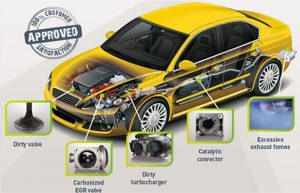 The EGR valve helps your car more efficiently and completely burn fuel by recirculating a portion of your exhaust and running it through the combustion process again. This results in a cooler, more complete burn of the fuel which decreases you car’s noxious emissions by prohibiting the formation of some harmful gases.
The EGR valve helps your car more efficiently and completely burn fuel by recirculating a portion of your exhaust and running it through the combustion process again. This results in a cooler, more complete burn of the fuel which decreases you car’s noxious emissions by prohibiting the formation of some harmful gases.
Pros
The EGR valve is vital to your car’s emission controls. Exhaust gas recirculation helps to keep huge amounts of unburned fuel from being released into the atmosphere. This unburned fuel is thought to be a huge contributor to greenhouse gas build-up. That’s why an EGR system became mandatory on all new vehicles some time ago.
Cons
When the EGR valve goes bad, it must be replaced. Unlike some emissions control devices that can go bad without affecting the drivability of the car or truck, a bad EGR valve can really affect the engine’s performance, or even cause it to stop running altogether. The good news is you can clean it.
 Description
Description
EGR Valve = Exhaust Gas Recirculation Valve.
The EGR valve controls formation of noxious emissions.
Rough idle and poor acceleration can be caused by a faulty EGR valve.
Guide Review – EGR Valve
The EGR valve, or Exhaust Gas Recirculation valve, is a vacuum controlled valve which allows a specific amount of your exhaust back into the intake manifold. This exhaust mixes with the intake air and actually cools the combustion process.  Cooler is always better inside your engine. The exhaust your EGR valve recirculates also prevents the formation of Nitrogen related gases. These are referred to as NOX emissions, and are a common cause for failing emissions testing. Unfortunately, your EGR valve can get stuck, causing NOX gases to build up. You’ll know if your EGR valve is stuck or malfunctioning because your car will experience symptoms like rough idle and bucking on acceleration. Fuel mileage will also suffer, and you may see a Check Engine light followed by a readable code in your car’s OBD-II or newer computer.
Cooler is always better inside your engine. The exhaust your EGR valve recirculates also prevents the formation of Nitrogen related gases. These are referred to as NOX emissions, and are a common cause for failing emissions testing. Unfortunately, your EGR valve can get stuck, causing NOX gases to build up. You’ll know if your EGR valve is stuck or malfunctioning because your car will experience symptoms like rough idle and bucking on acceleration. Fuel mileage will also suffer, and you may see a Check Engine light followed by a readable code in your car’s OBD-II or newer computer.
 Cleans your engine and elimates carbon.
Cleans your engine and elimates carbon.
 The EGR valve helps your car more efficiently and completely burn fuel by recirculating a portion of your exhaust and running it through the combustion process again. This results in a cooler, more complete burn of the fuel which decreases you car’s noxious emissions by prohibiting the formation of some harmful gases.
The EGR valve helps your car more efficiently and completely burn fuel by recirculating a portion of your exhaust and running it through the combustion process again. This results in a cooler, more complete burn of the fuel which decreases you car’s noxious emissions by prohibiting the formation of some harmful gases. Description
Description Cooler is always better inside your engine. The exhaust your EGR valve recirculates also prevents the formation of Nitrogen related gases. These are referred to as NOX emissions, and are a common cause for failing emissions testing. Unfortunately, your EGR valve can get stuck, causing NOX gases to build up. You’ll know if your EGR valve is stuck or malfunctioning because your car will experience symptoms like rough idle and bucking on acceleration. Fuel mileage will also suffer, and you may see a Check Engine light followed by a readable code in your car’s OBD-II or newer computer.
Cooler is always better inside your engine. The exhaust your EGR valve recirculates also prevents the formation of Nitrogen related gases. These are referred to as NOX emissions, and are a common cause for failing emissions testing. Unfortunately, your EGR valve can get stuck, causing NOX gases to build up. You’ll know if your EGR valve is stuck or malfunctioning because your car will experience symptoms like rough idle and bucking on acceleration. Fuel mileage will also suffer, and you may see a Check Engine light followed by a readable code in your car’s OBD-II or newer computer.
